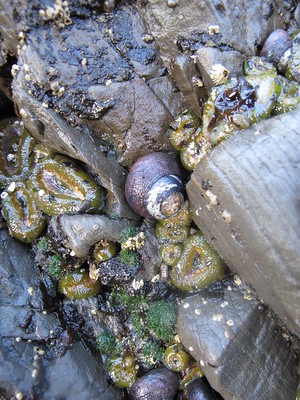If you don’t see the door, the snail is gone—dead and likely eaten.
 Turn a black turban snail over and you’ll see a circular, flat plate sealing the opening—in fact, you may get to watch the black snail close the door behind it as it pulls into its shell.These turban snails are called “black” because their bodies are black: the shells are charcoal gray. A bit rough in texture, patches of the outside of the shell often erode to purplish and the top of the spire usually wears down to the white mother-of-pearl beneath. Rather squat, with a short spire of rounded whorls, black turban snails can grow to about 1½” high and wide.
Turn a black turban snail over and you’ll see a circular, flat plate sealing the opening—in fact, you may get to watch the black snail close the door behind it as it pulls into its shell.These turban snails are called “black” because their bodies are black: the shells are charcoal gray. A bit rough in texture, patches of the outside of the shell often erode to purplish and the top of the spire usually wears down to the white mother-of-pearl beneath. Rather squat, with a short spire of rounded whorls, black turban snails can grow to about 1½” high and wide.
The closed door (also called an operculum) seals the opening to the shell, protecting the snail from drying out or from being eaten. Notice the concentric circles on the door? The door grows as the shell grows to accommodate the increasing size of the opening: the circles are the growth rings.
Even if the snail’s gone, the shell’s still of critical value in the tidepool: please leave them for other animals to use.
These turban snails are called “black” because their bodies are black: the shells are charcoal gray. A bit rough in texture, patches of the outside of the shell often erode to purplish and the top of the spire usually wears down to the white mother-of-pearl beneath. Rather squat, with a short spire of rounded whorls, black turban snails can grow to about 1½” high and wide.
Shells are valuable and are reused and recycled
Look closely at a shell—dead or live—and you may find barnacles, limpets, tube worms, or other animals or seaweeds attached. When the snail dies, hermit crabs and other animals may move in, as well. Eventually, even a sturdy shell will be broken down and the minerals will be dissolved in the water, later to be used by another animal to make a new shell.
Leaving shells on the beach keeps these precious resources available. Check out other tidepool etiquette tips.
